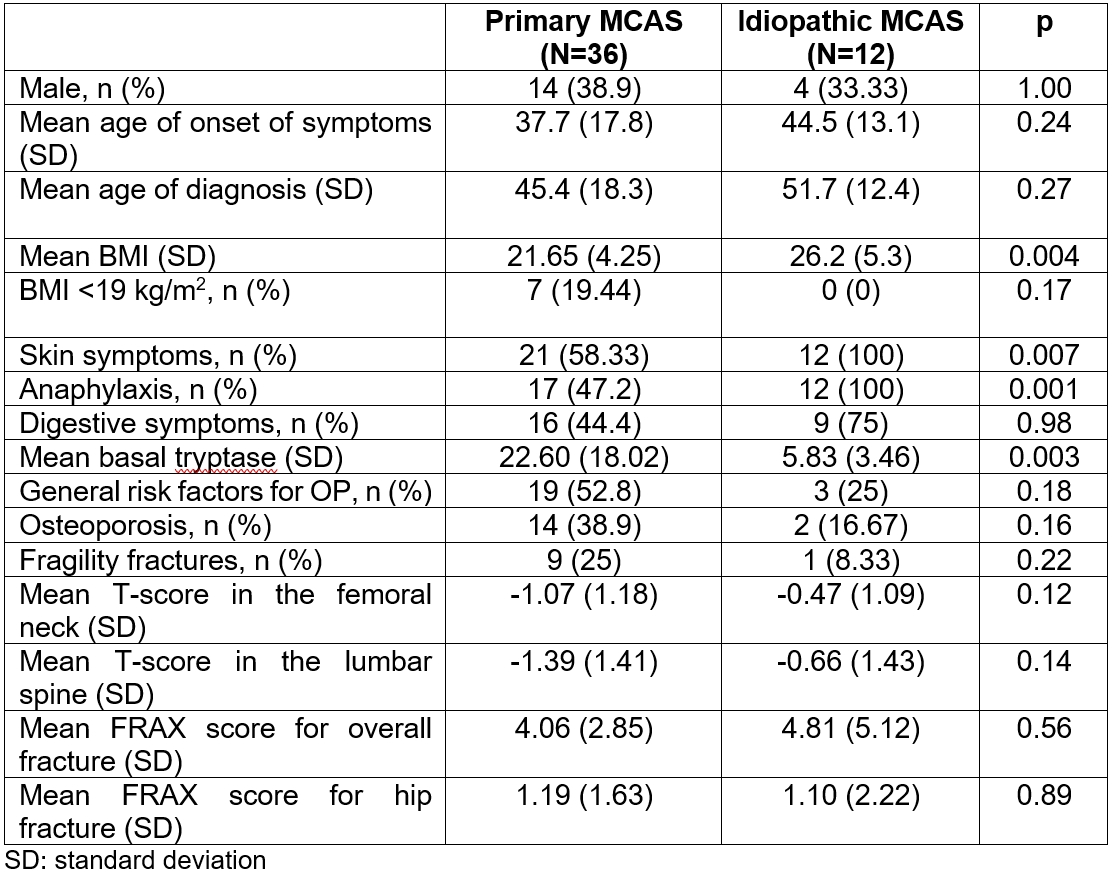Session Information
Date: Tuesday, November 14, 2023
Title: (1996–2018) Osteoporosis & Metabolic Bone Disease – Basic & Clinical Science Poster
Session Type: Poster Session C
Session Time: 9:00AM-11:00AM
Background/Purpose: Mast Cell Activation Syndromes (MCAS) are a group of disorders presenting with episodic multisystem symptoms, predominantly anaphylaxis, as the result of mast cell mediator release. Primary MCAS, that are those with a clonal origin such as systemic mastocytosis (SM), present a high prevalence of fragility fractures (FF), which varied from 5 to 37% of patients [1]. On the contrary, the idiopathic (non-clonal) forms of MCAS, do not appear to be associated with this risk [2]. The main objective of our study is to describe the presence of osteoporosis (OP), FF and the principal risk factors associated with FF in patients with MCAS.
Methods: The study population included all the patients with primary MCAS and idiopathic MCAS evaluated by the Rheumatology and Allergology departments at Hospital General Universitario Gregorio Marañón (Madrid, Spain), a tertiary-level hospital, until January 2023. The diagnosis was made according to the diagnostic and classification criteria updated in the consensus of 2021 [3]. Demographic, clinical, and analytical characteristics were collected. Bone involvement was defined as densitometric OP (T score ≤ -2.5) and/or the presence of FF on thoracic and lumbar spine X-rays. Fracture Risk Assessment Tool (FRAX) was used for estimating the risk of osteoporotic fracture with a 10-year probability. The differences between groups were tested using t-student test for continuous variables and chi-square test for categorical variables. A value of p < 0.05 was considered statistically significant.
Results: A total of 48 patients were included: 36 with primary MCAS (33 with mastocytosis, 5 cutaneous and 28 non-advanced systemic forms, and 3 clonal MCAS) and 12 patients with idiopathic MCAS. In the primary MCAS group, 25% of patients developed at least one FF, of which 44.4% were men with a mean age of 42 years (p=0.02); these patients also have a lower bone mineral density at the femoral neck (T-score -1.07; p=0.04) and a higher FRAX score compared to those who did not present fractures. In the group of patients with idiopathic MCAS, only one presented FF. Table 1 shows a comparison between the primary and idiopathic MCAS patients. Patients with primary MCAS have a higher prevalence OP and FF, higher tryptase levels (p=0.003) and a lower body mass index (BMI) (p=0.004). However, the risk of fracture calculated by FRAX, both for major and hip fractures, is increased in both groups.
Conclusion: The prevalence of OP and FF is higher in patients with primary MCAS compared to patients with idiopathic MCAS. A higher BMI and lower tryptase levels could explain the lower risk in the idiopathic MCAS group, although due to the small sample size the results must be handled with caution.
To cite this abstract in AMA style:
Ramos Lisbona A, Carpio Astudillo K, Skrabski F, Prieto García A, Castrejon I, Rivera J, Álvaro-Gracia J, González T. Clinical Characteristics and Risk Factors Associated with Fragility Fractures in Patients with Primary and Idiopathic Mast Cell Activation Syndromes [abstract]. Arthritis Rheumatol. 2023; 75 (suppl 9). https://acrabstracts.org/abstract/clinical-characteristics-and-risk-factors-associated-with-fragility-fractures-in-patients-with-primary-and-idiopathic-mast-cell-activation-syndromes/. Accessed .« Back to ACR Convergence 2023
ACR Meeting Abstracts - https://acrabstracts.org/abstract/clinical-characteristics-and-risk-factors-associated-with-fragility-fractures-in-patients-with-primary-and-idiopathic-mast-cell-activation-syndromes/

